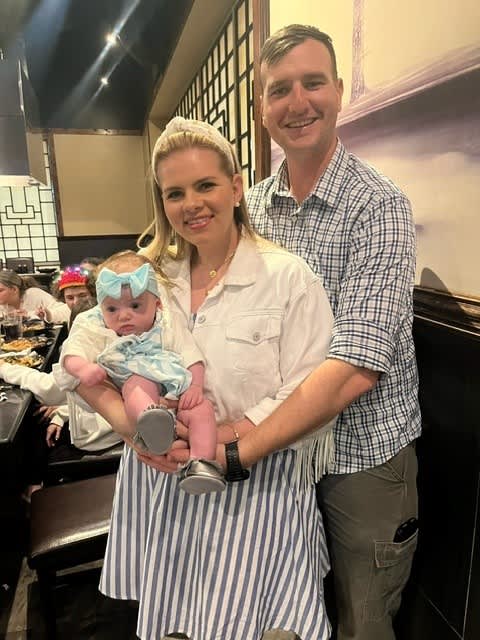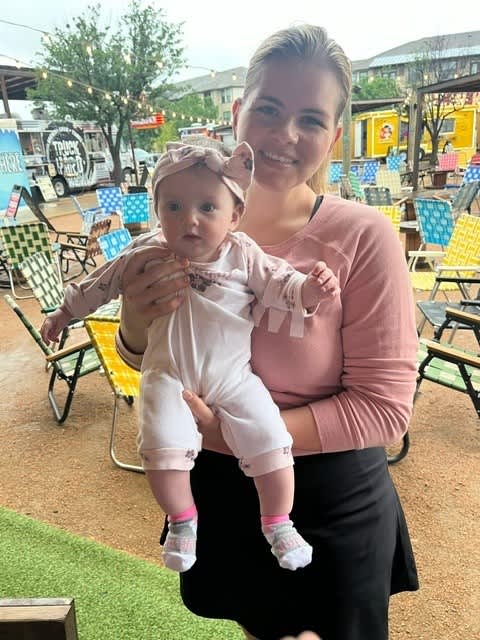Rare disease called cTTP poses challenge for new mom | Takeda Stories

A new mother faces the challenge of the rare disease cTTP

Amy (center) was diagnosed with cTTP after giving birth to her daughter.
New outlook on cTTP 100 years after disease was first identified
Everything turned out all right. The proof was in the back seat, in the form of Charlotte, strapped into her car seat and sleeping peacefully. This was the polar opposite of how she made her premature debut six months earlier.
Charlotte’s mom, Amy, recounted the harrowing story as she sat parked in her driveway, not wanting to wake up her daughter. Thinking back on that day, Amy’s voice broke as she described feeling sick.
“I wrote it off as being nine months pregnant,” she says. “She is my first baby and I thought, ‘This is what it must be like.’”
But she began vomiting in the early morning hours and couldn’t stop. Then she began shivering. That’s when her professional instincts – Amy is an intensive care unit (ICU) nurse in Texas – kicked in and she knew this was not normal. She and her husband, Mark, rushed to the hospital.
“I had aphasia, where I can’t express in words what I want to tell them,” she says. “I kept wanting to say, ‘Mark, this is bad. Really bad.’ But I couldn’t get the words out. It was a nightmare.”
Charlotte was born at 12:44 p.m. on Christmas Eve. The baby was healthy, but Amy’s hospital stay was just beginning.
Her healthcare team worked tirelessly during the following week to determine what was wrong with her. They ruled out a stroke and other maladies but were perplexed as the symptoms persisted.
“As a nurse, I saw the uncertainty in the doctors,” Amy says. “I was afraid I might die and never have my daughter get to know me.”
Finally, on New Year’s Eve, a week after Charlotte was born, Amy’s medical team found the answer.
Amy had congenital thrombotic thrombocytopenic purpura (cTTP), an ultra-rare disease first identified 100 years ago that results in a deficiency in the ADAMTS13 enzyme that causes blood clots to form in small blood vessels.1,2,3 It is so rare that Amy, a healthcare professional, had never heard of it.

“No one wants to be that one in a million. No one wants to believe it.”
Amy
A goal of making people better
cTTP has both acute and chronic manifestations – including stroke and cardiovascular disease – and left untreated has a mortality rate of more than 90 percent. For nearly a century, cTTP patients had limited treatment options and none specifically indicated for them. 1,2,4
Obi Umeh, the global program leader in our Rare Gastrointestinal and Inflammation Therapeutic Unit, leads a team that has focused on addressing the unmet needs of treating cTTP.
“Rare diseases by definition don’t get a lot of attention, but that doesn’t mean the people living with them are any less deserving of care – and the cTTP community has gone far too long without a treatment option that specifically treats their disease,” Dr. Umeh says. “Our focus for over 240 years has been tireless innovation with a goal of helping patients live their best lives, regardless of the prevalence of the disease.”

The family of Reeshemah Wynn established the Ree Wynn Foundation to support patients with TTP shortly after she died from the disease in January 2012.
Driven by the voices of the patients
“We were in shock,” James says. “Right after she passed, my mother asked me to work on her obituary, and she requested that people don’t send flowers or gifts, just donations to a TTP foundation. And that’s when we realized that this disease was so rare there was no TTP foundation.”
Twelve years later, the all-volunteer foundation is thrilled that treatment advances are being made.
“We’re driven by the voices of the patients,” James says. “For so long, they had no voice. It is comforting for them to know that scientists and medical professionals are listening to what they are saying and trying to make their lives better.”
A fresh perspective
Amy is a beneficiary of the advances that cTTP patients have waited so long for. She is now managing her disease with the help of her doctor and has returned to work with a fresh perspective on patient care. She’s now using her voice to help patients in her care, as well as others who may be searching for a diagnosis or treatment.
“I have always listened to my patients – they know best what they’re feeling,” she says. “But having gone through this ordeal, I feel their fear and uncertainty. If what I went through can help even one person, it would have been worth it. I want them to know now that I’m never going to stop trying to understand what their needs are and to meet them.”
- Van Dorland H et al. Haematologica. 2019;104:2107-16
- Nunez Zuno JA and Khaddour K. Thrombotic Thrombocytopenic Purpura Evaluation and Management. https://www.ncbi.nlm.nih.gov/books/NBK470585/ Accessed August 2024
- Chiasakul T and Cuker A. Am Soc Hematol. 2018;2018(1):530–538
- Zheng XL et al. J Thromb Haemost. 2020;18(10):2486-95
Share this story



